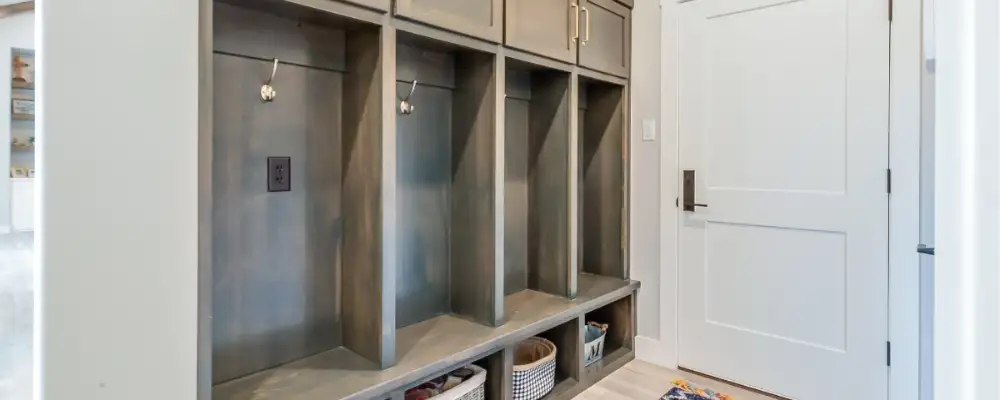A home is a place where one can occupy for shelter and well-being. Different rooms are built to serve their unique purpose of benefiting the occupants. For example, bathrooms, bedrooms, living rooms, kitchens, etc. Among these, the mudroom occupies its own space. It is an essential part of any home that requires only a small space but delivers exceptional benefits for the users. Let us discuss the key features, benefits, and types of mudrooms that will be useful in your daily life.
What is a Mudroom in a House?
A mudroom is a functional space or area where one can shrug off their backpack or shoes before entering the house. This space is usually built at the entrance of the house and serves as the entryway to any house. In the winter and summer seasons, storing necessities in a small convenience space and using it whenever possible will be helpful. You can also use this space as storage, for laundry, or as an entryway. If you have children, this space will be very useful for you.
Where is a Mudroom Typically Located?

A mudroom serves as the comfortable little area that is located close to your front door where everything gets a little more organised. Before entering the rest of the home, you can kick off your shoes, take off your muddy boots, and shed your damp jackets, gloves, and scarves there. After a hectic day, consider it a place to stop, sit, and take a deep breath. In addition to keeping dirt out, it’s ideal for storing coats, hats, pet leashes, and even athletic equipment.
How Can You Utilise a Mudroom?
You can utilise your mudroom for multiple purposes. Simple add-ons will help you maintain the cleanliness of your mudroom. Let us see how you can use your versatile mudroom.
Optimise Your Storage
Make your mudroom the primary location for keeping sports equipment, backpacks, and gym bags. Make sure that every family member has a specific location for easy access and organisation by adding shelves, cubbies, or lockers for their items.
Be Prepared for Heavy Traffic
You may expect your mudroom to deal with a lot of damp and dirty shoes. Install an indoor/outdoor rug that is easy to clean, long-lasting, and absorbent. To keep the area neat and useful, combine it with a non-porous, easily cleaned floor like tile, stone, concrete, or sealed wood.
Include Laundry Features
Add laundry facilities to your mudroom to create a hybrid area. As soon as individuals enter the house, muddy garments, socks, and coats can be put immediately in the washing machine. Store extra clothes or robes in each locker or cubby for easy changing, preventing mess and maintaining a tidy home.
What are the Key Features of a Mudroom?
The mudroom will have its own identity and serve a certain function, just like any other room in your house. A few key features of a mudroom that are both aesthetically pleasing and useful are as follows:
A Seating Area
A bench or a couple of chairs gives your mudroom a practical and hospitable feel. It offers a cosy place to sit while taking off boots or shoes. To maintain the area functional and orderly, choose a seat with built-in storage to properly store bags, umbrellas, and other necessities.
Hooks
An essential component of any mudroom is hooks. They keep clutter from spreading around the room by offering a convenient and accessible method to hang bags, hats, coats, and jackets. Hooks that are positioned correctly keep your mudroom organised and guarantee that commonly used items are always accessible.
Baskets or Storage Bins
For storing tiny goods that are prone to being lost, such as hats, scarves, or gloves, storage boxes or baskets are ideal. Add bins or baskets to cubbies to suit special requirements, like gardening tools, sports equipment, or outdoor toys. This arrangement keeps things organised and facilitates finding what you need quickly.
A Mudroom Mat

A sturdy mudroom mat is necessary because the word “mud” appears in the room’s name! It keeps the rest of your house clean by collecting water, mud, and filth from shoes and boots. Choose a mat that is both washable and absorbent, made to withstand heavy traffic and soiled shoes.
Waterproof Whatever You Can
Think about waterproofing as much of your mudroom as you can to keep it durable and clean. Make use of waterproof paint, sealants, or flooring materials like tile or vinyl. Waterproof surfaces can endure the rigours of a busy, high-traffic location and are simpler to clean. This simple step guarantees that your mudroom will remain in top shape for many years to come.
What Are the Benefits of a Mudroom?
Having a mudroom has several advantages, including cleanliness and organisation.
Keep Yourself Organised with Mudrooms
Coats, shoes, umbrellas, and backpacks can be stored in a well-designed mudroom. You can store these basic items in the mudroom rather than scattered all over the house. It makes it simpler to keep your living area neat and organised. This allows you to spend only a few minutes on your daily cleaning activities.
Maintain a Clean Home with Mudrooms
By providing a place to take off soiled shoes and coats before entering the home, mudrooms also aid in maintaining cleanliness. For families with kids who frequently bring the outside dirt to the inside home after recreation, this is especially helpful because it keeps mud and filth from being tracked inside.
Conclusion
In conclusion, every home must have a small mudroom either in their entryway or in their backyard. A mudroom is a distinct and separate space in your home where you may store items and spend some time relaxing when you return home. It is also helpful to keep the rest of your home clean and organised. You can maintain the cleanliness of your home and prevent filth from getting everywhere by adding a mudroom. It’s similar to having a designated spot to store your outdoor belongings to keep your house tidy!

